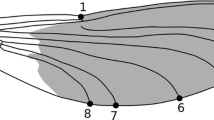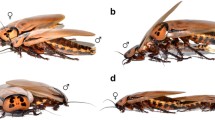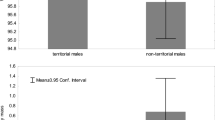Abstract
A trade-off between flight capability and reproduction is well known in adult females of the wing-dimorphic cricket Velarifictorus ornatus, but it is not clear whether such a trade-off exists in adult males of the species. In the present study, we investigated sexual maturation time, mating frequency, and the fertilization success of spermatophores after sequential mating in long-winged (LW) and short-winged (SW) adult males of V. ornatus to evaluate the potential reproductive advantage of the SW over the LW male morph. We found that the SW males of V. ornatus attained sexual maturity earlier and produced heavier spermatophores during the early stage after adult emergence than their LW counterparts. Additionally, within a 24-h mating period, the SW males showed a higher mating frequency, greater spermatophore weight, and shorter intermating time interval compared with their LW counterparts. Although females copulated with the two male morphs produced eggs of similar size, fertilization success by SW males was significantly higher than by the LW males. These results provide support for a trade-off between dispersal capability and reproduction success in wing-dimorphic males of V. ornatus.





Similar content being viewed by others
References
Biere, A. (1995). Genotypic and plastic variation in plant size-effects on fecundity and allocation patterns in Lychnis flos-cuculi along a gradient of natural soil fertility. Journal of Ecology, 83, 629–642.
Burpee, D. M., & Sakaluk, S. (1993). Repeated matings offset costs of reproduction female crickets. Evolutionary Ecology, 7, 240–250.
Crnokrak, P., & Roff, D. A. (1995). Fitness differences associated with calling behavior in the two morphs of male sand cricket, Gryllus firmus. Animal Behaviour, 50, 1475–1481.
Daly, M. (1978). The cost of mating. American Naturalist, 112, 771–774.
Dowling, D. K., & Simmons, L. W. (2012). Ejaculate economics: Testing the effects of male sexual history on the trade-off between sperm and immune function in Australian crickets. PLoS ONE, 7(1), e30172. doi:10.1371/journal.pone.0030172.
Eberhard, W. G. (1996). Female control: Sexual selection through cryptic female choice. Princeton, NJ: Princeton University Press.
Fairbairn, D. J., & Preziosi, R. F. (1996). Sexual selection and the evolution of sexual size dimorphism in the water strider, Aquarius remigis. Evolution, 50, 1549–1559.
Fujisaki, K. (1992). A male fitness advantage to wing reduction in the oriental chinch bug, Cavelerius saccharivorus Okajima (Heteroptera: Lygaeidae). Researches on Population Ecology, 34, 173–183.
Guerra, P. A. (2011). Evaluation the life-history trade-off between dispersal capability and reproduction in wing dimorphic insects: A meta-analysis. Biological Reviews, 86, 813–835.
Guerra, P. A., & Pollack, G. S. (2007). A life history trade-off between flight ability and reproductive behavior in male field crickets (Gryllus texensis). Journal of Insect Behavior, 20, 377–387.
Guerra, P. A., & Pollack, G. S. (2009). Flight behaviour attenuates the trade-off between flight capability and reproduction in a wing polymorphic cricket. Biology Letters, 5, 229–231.
Guerra, P. A., & Pollack, G. S. (2010). Colonists and desperadoes: Different fighting strategies in wing-dimorphic male Texas field crickets. Animal Behaviour, 79, 1087–1093.
Holtmeier, C. L., & Zera, A. J. (1993). Differential mating success of male wing morphs of the cricket, Gryllus rubens. American Midland Naturalist, 129, 223–233.
Kumashiro, M., Tsuji, Y., & Sakai, M. (2003). Auto-spermatophore extrusion in males crickets. The Journal of Experimental Biology, 206, 4507–4519.
Langellotto, G. A. (2001). Benefits of dispersal in patchy environments: Mate location by males of a wing-dimorphic insect. Ecology, 82(7), 1870–1878.
Langellotto, G. A., Denno, R. F., & Ott, J. R. (2000). A trade-off between flight capability and reproduction in males of a wing-dimorphic insect. Ecology, 81(3), 865–875.
Lanman, J. T. (1968). Delays during reproduction and their effectss on the embryo and fetus. New England Journal of Medicine, 278, 993–999.
Mishiro, K., Fujisaki, K., & Nakasuji, F. (1994). Comparison of female reproductive effort and male mating success between macropterous and brachypterous forms of the small brown planthopper, Laodelphax striatellus (Homoptera: Delphacidae). Applied Entomology and Zoology, 29, 211–217.
Mowles, S. L. (2014). The physiological cost of courtship: field cricket song results in anaerobic metabolism. Animal Behaviour, 89, 39–43.
Parker, G. A., & Pizzari, T. (2010). Sperm competition and ejaculate economics. Biological Reviews, 85, 897–934.
Reinhardt, K., & Siva-Jothy, M. T. (2005). An advantage for young sperm in the house cricket Acheta domesticus. The American Naturalist, 165(6), 718–723.
Roche, J. F., Dziuk, P. J., & Lodge, J. R. (1968). Competition between fresh and aged spermatozoa in fertilizing rabbit eggs. Journal of Reproduction and Fertility, 16, 155–157.
Roff, D. A., & Fairbairn, D. J. (1994). The evolution of alternate morphologies: Fitness and wing morphology in male sand crickets. Evolution, 47, 1572–1584.
Sack, C., & Stern, D. (2007). Sex and death in the male pea aphid, Acyrthosiphon pisum: the life-history effects of a wing dimorphism. Journal of Insect Science, 7(45), 1–9.
Sakaluk, S. K. (1997). Cryptic females choice predicated on wing dimorphism in decorated crickets. Behavioral Ecology, 8(3), 326–331.
Schlichting, C. D., & Pigliucci, M. (1998). Phenotypic evolution: A reaction norm perspective. Sunderland, MA: Sinauer Associates.
Siva-Jothy, M. T. (2000). The young sperm gambit. Ecology Letters, 3, 172–174.
Socha, R. (2004). Decreased mating propensity of macropterous morph in a flightless wing-polymorphic insect, Pyrrhocoris apterus (Heteroptera). European Journal of Entomology, 101, 539–545.
Socha, R. (2008). Wing morph- and age-related differences in fertilization success of adult males of a flightless bug, Pyrrhocoris apterus (Heteroptera: Pyrrhocoridae). European Journal of Entomology, 105, 93–98.
Socha, R., & Hodková, M. (2006). Corpus allatum volume-dependent differences in accessory gland maturation in long- and short-winged males of Pyrrhocoris apterus (Heteroptera: Pyrrhocoridae). European Journal of Entomology, 103, 27–32.
Stearns, S. C. (1976). Life-history tactics: A review of the ideas. Quarterly Review of Biology, 51, 3–47.
Tanaka, S. (1993). Allocation of resources to egg production and flight muscle development in a wing dimorphic cricket, Modicogryllus confirmatus. Jounral of Insect Physiology, 39, 493–498.
Tarín, J. J., Pérez-Albalé, S., & Cano, A. (2000). Consequences on offspring of abnormal function in ageing gametes. Human Reproduction Update, 6, 532–549.
Trivers, R. L. (1972). Parental investment and sexual selertion. In B. Campbell (Ed.), Sexual selection and the descent of man. Chicago, IL: Aldine.
Wagner, W. E., Jr. (2005). Male field crickets that provide reproductive benefits to females incur higher costs. Ecological Entomology, 30, 350–357.
Wang, Q., & Davis, L. K. (2006). Females remate for sperm replenishment in a seed bug: Evidence from offspring viability. Journal of Insect Behavior, 19(3), 337–346.
Zeng, Y., & Zhu, D. H. (2012). Trade-off between flight capability and reproduction in male Velarifictorus asperses crickets. Ecological Entomology, 37, 244–251.
Zeng, Y., Zhu, D. H., & Zhao, L. Q. (2014). Critical flight time for switch from flight to reproduction in the wing dimorphic cricket Velarifictorus asperses. Evolutionary Biology, 41, 397–403.
Zera, J. A., & Denno, R. F. (1997). Physiology and ecology of dispersal polymorphism in insects. Annual Review Entomology, 42, 207–230.
Zhao, L. Q., Zhu, D. H., He, Y. Y., & Yang, Y. P. (2008). Effects of changing photoperiod on nymphal development in a cricket (Velarifictorus ornatus). Acta Ecologica Sinica, 28, 253–260.
Zhao, L. Q., Zhu, D. H., & Zeng, Y. (2010). Physiological trade-offs between flight muscle and reproductive development in the wing-dimorphic cricket Velarifictorus ornatus. Entomologia Experimentalis et Applicata, 135, 288–294.
Acknowledgments
This work was supported by National Nature Science Foundation of China (no. 31200494). We thank Z.W. Liu of Eastern Illinois University (USA) for linguistic revision.
Author information
Authors and Affiliations
Corresponding author
Ethics declarations
Conflict of interest
The authors declare that they have no conflict of interest.
Additional information
Lv-Quan Zhao and Huai-lin Chai contributed equally to this work.
Rights and permissions
About this article
Cite this article
Zhao, LQ., Chai, Hl. & Zhu, DH. Potential Reproductive Advantage of Short-over Long-Winged Adult Males of the Cricket Velarifictorus ornatus . Evol Biol 44, 91–99 (2017). https://doi.org/10.1007/s11692-016-9395-2
Received:
Accepted:
Published:
Issue Date:
DOI: https://doi.org/10.1007/s11692-016-9395-2




